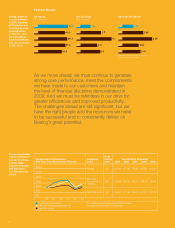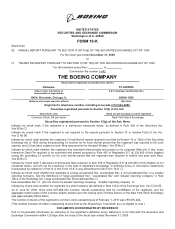Boeing 2009 Annual Report Download - page 20
Download and view the complete annual report
Please find page 20 of the 2009 Boeing annual report below. You can navigate through the pages in the report by either clicking on the pages listed below, or by using the keyword search tool below to find specific information within the annual report.Our U.S. government business is also subject to specific procurement regulations and other
requirements. These requirements, although customary in U.S. government contracts, increase our
performance and compliance costs. These costs might increase in the future, reducing our margins,
which could have a negative effect on our financial condition. Failure to comply with these
regulations and requirements could lead to suspension or debarment, for cause, from U.S.
government contracting or subcontracting for a period of time and could have a negative effect on
our reputation and ability to secure future U.S. government contracts.
We enter into fixed-price contracts, which could subject us to losses if we have cost overruns.
Many of our contracts in BDS and most of our contracts in Commercial Airplanes are on a fixed-price
basis. Approximately 50% of BDS revenues are generated from fixed-price contracts. While firm fixed
price contracts enable us to benefit from performance improvements, cost reductions and efficiencies,
they also subject us to the risk of reduced margins or incurring losses if we are unable to achieve
estimated costs and revenues. If our estimated costs exceed our estimated price, we recognize reach-
forward losses which can significantly affect our reported results.
The long term nature of many of our contracts and programs makes the process of estimating costs
and revenues on fixed price contracts inherently risky. For example commercial jet aircraft are normally
sold on a firm fixed-price basis with an indexed price escalation clause. These escalation clauses
account for economic fluctuations over the period of time from sale to delivery which can span many
years. A price escalation formula based on pre-defined factors is used to determine the final price of
the airplane at the time of customer delivery. Changes in future estimates of the underlying price
escalation index can significantly impact estimated revenues and margins in any quarter. Fixed price
contracts in our BDS business often contain price incentives and penalties tied to performance which
can be difficult to estimate and have significant impacts on margins. In addition, some of our contracts
have specific provisions relating to cost, schedule and performance. If we fail to meet the terms
specified in those contracts, our sales price could be reduced, which would adversely affect our
financial condition.
Fixed-price development work inherently has more uncertainty than work pursuant to production
contracts and, therefore, more variability in estimates of the cost to complete the work. Fixed price
development contracts inherently have more uncertainty than fixed price production contracts.
Examples of significant BDS fixed-price development contracts include AEW&C, International KC-767
Tankers and commercial and military satellites. Examples of significant Commercial Airplanes
development programs include the 787 and 747-8. Many of these development programs have very
complex designs. As technical or quality issues arise, we may experience schedule delays and higher
costs to complete. Additionally, price escalation factors may also impact margins by reducing the
estimated price of airplanes delivered in the future. Both of these factors may ultimately result in a
material charge if the program has or is determined to have a reach forward loss. Successful
performance depends on our ability to meet production specifications and delivery rates. If we are
unable to perform and deliver to contract requirements, our contract price could be reduced through
the incorporation of liquidated damages, termination of the contract for default, or other financially
significant exposure. Management uses its best judgment to estimate the cost to perform the work, the
price we will eventually be paid and, in the case of commercial programs, the number of units to
include in the initial accounting quantity. While we believe the cost and price estimates incorporated in
the financial statements are appropriate, future events could result in either upward or downward
adjustments to those estimates. Changes to estimates of the program accounting quantity, production
costs and rates, learning curve, costs of derivative aircraft, customer negotiations/settlements, supplier
claims and certification issues could also result in lower margins or reach-forward losses. We may
continue to experience technical and quality issues requiring further delays in schedule or revisions to
our cost estimates.
8
























